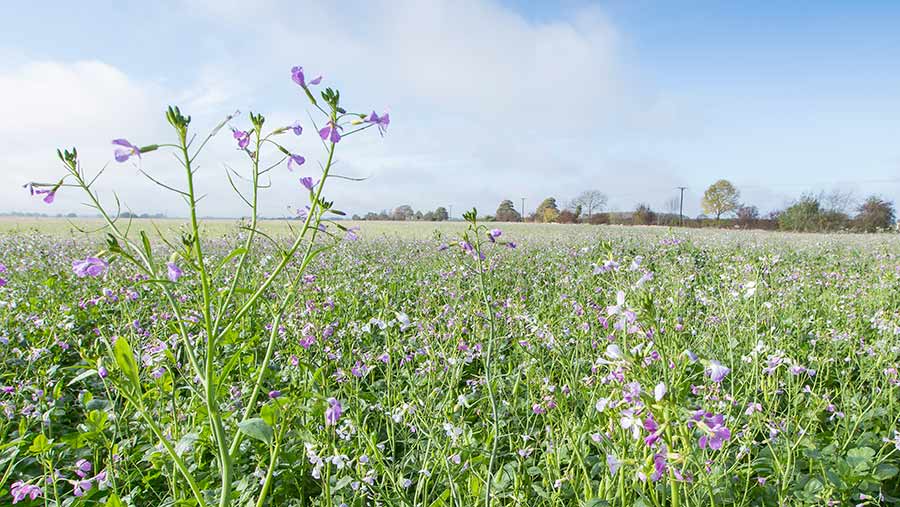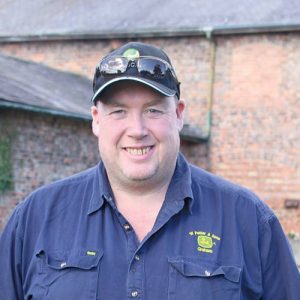How three growers hope to improve soil health in Yorkshire
 © Gary Naylor
© Gary Naylor A recently launched initiative aimed at improving the health of Yorkshire’s arable soils is already seeing success, with dozens of farmers growing more than 400ha of cover crops for the first time this autumn.
Growers taking part in the Sustainable Landscapes programme are also using less metaldehyde, as they are being encouraged to switch to ferric phosphate slug pellets in order to stop the chemical entering rivers. The initiative is covering the extra cost incurred from the switch.
As in other parts of the UK, the loss of metaldehyde and soil from arable fields into rivers is a key issue affecting water quality.
See also: How ‘conservation agriculture’ can improve soil health
For example, Yorkshire Water recovers on average 23,000 tonnes of soil a year at its water treatment works on the Derwent and the Ouse.
Disposing of this soil is not just a headache for the utility company. It also means arable farms are losing a vital resource and are, therefore, not sustainable in the long term.
David Blacker, who farms 490ha of crops north of York, recalls a recent visit to one of the treatment works.
“When you see that mountain of soil, you realise it is our topsoil that is being lost. So how do we stop this?”
Three pilot areas
To address this soil loss, Mr Blacker is helping to drive the Yorkshire Water-funded initiative along with fellow growers Graham Potter and James Hopwood. Each has set up a pilot area.
About 15 farms have signed up in each area and the three farmers plan to host regular meetings to share knowledge and best practice, as well as demonstrate their achievements.
For example, Mr Potter has raised the soil organic matter content of one previously problematic field from 1.5% to 4%.

The initiative covers the extra cost of switching from metaldehyde slug pellets to ferric phosphate
This was done with a combination of chopping and incorporating straw and growing cover crops.
“Fields that have had cover crops no longer have standing water during wet spells,” he reports.
Developing techniques
It is not just about demonstrating what the host farmers have achieved. The programme is also investigating new approaches to managing soils.
Andrew Walker, catchment manager at Yorkshire Water, says the aim is to identify the key factors for achieving healthy soils. Next year will see new practical guidance, including flowcharts to help Yorkshire farmers solve common soil problems.
Ultimately, this will lead to more sustainable arable businesses as well as improved water quality.
Sustainable Landscapes
Measures being promoted
- Increase soil organic matter and reduce leaching risk by growing cover crops (members get free seed for 30 acres).
- Make greater use of non-chemical approaches to slug control such as double rolling.
- Switch from metaldehyde to ferric phosphate pellets (project covers extra cost).
Other activities
- Competition for the biggest cover crop this autumn.
- Trials of techniques such as variable slug pellet applications.
- A detailed examination of soil quality by Precision Decisions, comparing the best performing fields with those that are underperforming to understand why.
- Any improvements in sustainability of arable farms taking part will be measured using a unique Sustainability Index developed by Future Food Solutions.
Refining soil management techniques
Pilot area 1: Graham Potter, Topcliffe, near Thirsk – Targeted use of slug pellets and cultural control

Graham Potter
Graham Potter is looking to get more from cultural approaches to slug control, in a bid to reduce pellet use on his farm in North Yorkshire.
His increased focus on the pest started last year. “It was a bad year for slugs and we were seeing severe damage in crops,” he recalls.
Using soil conductivity maps, he then went out to slug trap the different areas to see how slug numbers differed between the varying soil types, with the aim of generating variable pelleting maps.
Instead of blanket applying pellets, some areas including light sandy soils received no pellets while the high risk areas received up to 6-7kg/ha. This targeted approach has led to an overall reduction in pellet use.
This autumn, he is looking to reduce slug pellet use further by maximising cultural controls.
Stubble rakes are often seen as a way of reducing populations by exposing slug eggs to drying conditions. However, he points out that this is not as effective in the north, where the weather is wetter.
This summer, he ran a Claydon Terrastar over the stubble after harvest to create a 5cm tilth and he has been raking it once a week to maximise kill.
Then in mid-September he put traps out to assess the impact on slug numbers and will apply pellets where thresholds have been exceeded.
“Combine yield maps are also useful as you can match up bad slug areas with low yielding spots,” he says.
Over time, he hopes to refine his approach by gaining knowledge of what slugs like and don’t like, as well as understanding where hotspots are.
Pilot area 2: David Blacker – Better use of cover crops

David Blacker
David Blacker, who farms heavy land north York, operates a strip-till system and he is hoping to get more from his cover crops next spring.
He is looking at the timing of cover crop destruction before establishing a spring crop within this project, and is also involved in a cover crop project with Adas.
Mr Blacker believes he is not yet getting it right, as he has not always seen the yield benefits in the following crop reported by other farmers.
“In fact, we have often see a yield decrease rather than an increase in following crops.”
He believes this could be down to timing of destruction, being too late to reap the benefits of any nutrients being released as the crop breaks down in the soil.
Crops will be destroyed at three different timings: just before Christmas, six weeks before drilling, and just after drilling with the drill going through a green crop.
The trial is being carried out in two different cover crop mixes and members will be able to see the results for themselves.
Pilot area 3: James Hopwood – Cover crops and water quality
James Hopwood’s family farms 250ha of diverse cropping on medium to sandy loams just south of York, in a plough-based system.
Cropping includes wheat, oilseed rape, winter and spring barley, hemp for fibre, beans, and potatoes for processing. About a quarter of the farm is light enough for carrots and is rented out.
He is working with the University of Leeds to investigate the impact of cover cropping on water quality. His interest is because a key dyke flows through his land and into the River Ouse.
“On one side we have no cover crop and the other side we have a winter mix,” he says. Researchers will monitor water quality over the winter.
Farmers in his pilot area will also hear about how mapping has helped Mr Hopwood even up P and K indices in his soils.
“We have been mapping soils for at least 12 years and have now four sets of data across the area. Even after two rotations, we saw a big improvement.”
Mr Hopwood is also interested in promoting soil health through the use of bacterial soil supplements and has seen promising results with bacillus species.
“Even though 2018 was a dry year, we have seen a 50% increase in respiration rates,” which is a measure of soil biology. He hopes to do more work on this through the initiative.
What is Sustainable Landscapes?
Developed by Yorkshire Water and Future Food Solutions, Sustainable Landscapes is a five-year programme that kicked off this spring.
What makes it unique is that farmers are driving the programme, working with other parts of the food chain including global brands such as Heineken and Pepsico.
Yorkshire Water’s Andrew Walker points to the recent success in upland areas, where a more collaborative approach has led to improved bog health.
The aim is to replicate this approach in the Yorkshire lowlands and eventually produce a soil strategy.
He stresses that it’s not just about improving water quality in river catchments: there are also large benefits for farmers, as keeping more soil in fields will result in more sustainable businesses.
One measure likely to be part of the strategy is to encourage farmers to raise soil organic matter, says Paul Rhodes, director of consultancy company Future Food Solutions.
“For every 1% increase in soil organic matter, there is a 150-200t/ha increase in water holding capacity,” he says.
Not only is this valuable in a dry summer like 2018, it could also help reduce flooding further down river by keeping more water out of rivers, he adds.

